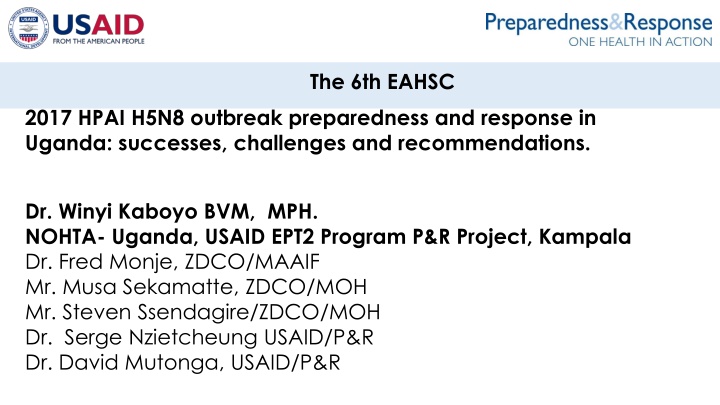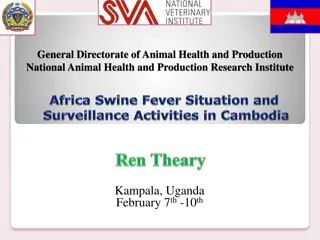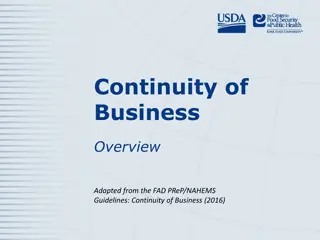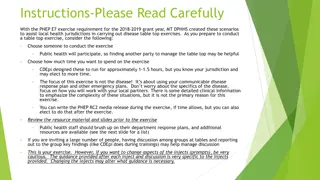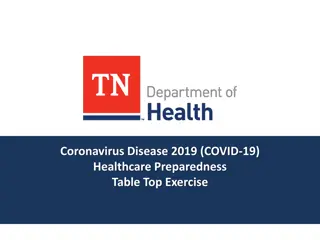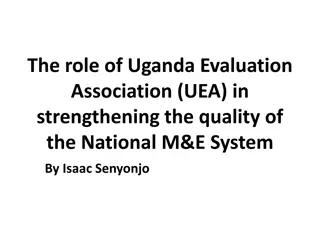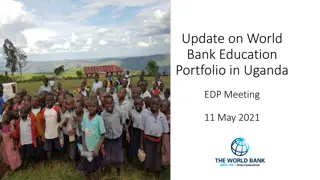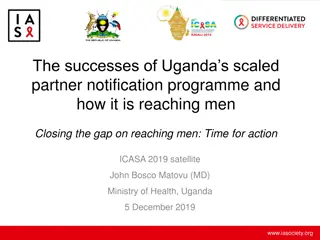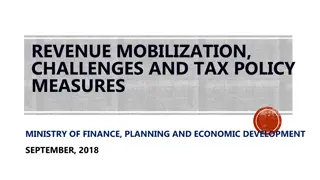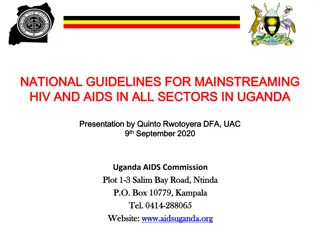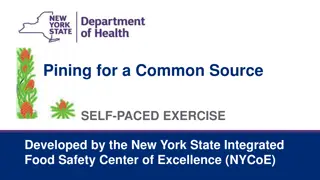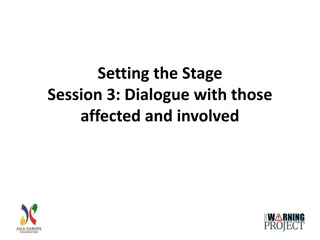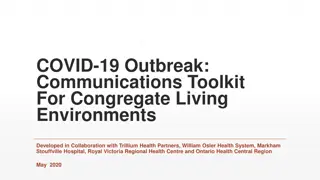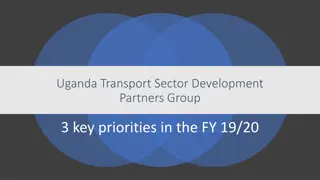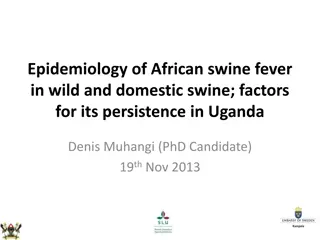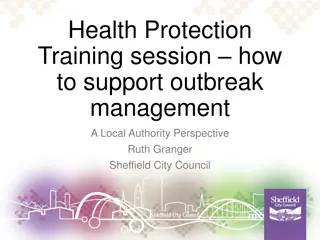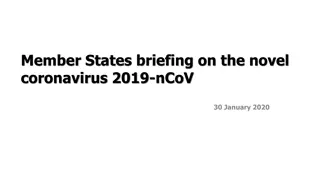H5N8 Outbreak Preparedness and Response in Uganda: Successes and Challenges
Uganda's response to the recent H5N8 outbreak, including surveillance, investigations, and actions taken to prevent spread. Learn about infrastructure development, training programs, and community sensitization efforts. Recommendations for future preparedness included.
Download Presentation

Please find below an Image/Link to download the presentation.
The content on the website is provided AS IS for your information and personal use only. It may not be sold, licensed, or shared on other websites without obtaining consent from the author.If you encounter any issues during the download, it is possible that the publisher has removed the file from their server.
You are allowed to download the files provided on this website for personal or commercial use, subject to the condition that they are used lawfully. All files are the property of their respective owners.
The content on the website is provided AS IS for your information and personal use only. It may not be sold, licensed, or shared on other websites without obtaining consent from the author.
E N D
Presentation Transcript
The 6th EAHSC 2017 HPAI H5N8 outbreak preparedness and response in Uganda: successes, challenges and recommendations. Dr. Winyi Kaboyo BVM, MPH. NOHTA- Uganda, USAID EPT2 Program P&R Project, Kampala Dr. Fred Monje, ZDCO/MAAIF Mr. Musa Sekamatte, ZDCO/MOH Mr. Steven Ssendagire/ZDCO/MOH Dr. Serge Nzietcheung USAID/P&R Dr. David Mutonga, USAID/P&R
Introduction & country context Uganda lies along the pathway of wild migratory birds flying from the northern to southern hemisphere during winter in Europe HPAI outbreaks have been reported in many countries in Europe the 2016/2017 winter season Although no HPAI had ever been confirmed in Uganda, a pandemic influenza H1N1 outbreak was reported in 2009-2010 with 261human cases but no deaths. The H1N1 outbreak enable the country to build infrastructure and human capacity to prepare and respond to HPAI Through the AHIP Project 2010-2014: HPAI Preparedness & Response Plan and a Communication Strategy were developed ; two BSL3 laboratories were built at Uganda Virus Research Institute (UVRI ) of Ministry of Health (MOH) & National Animal Diseases diagnostic and Epidemiology Centre (NADDEC ) of Ministry of Agriculture, Animal Industry & Fisheries (MAAIF); One Isolation unit was constructed & equipped at Entebbe Hospital; National and district staff were trained and skilled on key aspects of HPAI prevention and control; Guidelines and treatment protocols were developed, printed and disseminated; Communities were sensitized.
The recent H5N8 Outbreak The government was first alerted of the outbreak through the Uganda wildlife Education Centre (UWEC) by fishermen on January 2, 2017 Fishermen had since Nov /Dec 2016 observed massive deaths of wild migratory birds (white winged black terns) at Lutembe bay in Wakiso district on Lake Victoria shores. Investigations were immediately started by government using the One Health approach through the Zoonotic Disease Coordination Office (ZDCO) in collaboration with research agencies and partners. Samples from dead and sick wild migratory birds were submitted to human and animal diagnostic laboratories at Entebbe and water samples were also tested at the Government analytical laboratory in Kampala for possible chemical poisoning of these birds. Chemical poisoning was ruled out but HPAI (H5) was confirmed, although the N subtype had not been determined an outbreak of HPAI was declared by the Minister of Agriculture on January 15, 2017. National Task Force (NTF) started meeting regularly and investigations were extended to Masaka (Bukakata landing site) and Kalangala district where large numbers of migratory birds had also died.
Map of Uganda showing Bukakata, Bubeke and Lutembe Landing sites in Masaka, Kalangala and Wakiso Districts respectively where H5N8 pathogens have been identified in both migratory and domestic birds Lutembe Bukakata Bubeke island
Successes The major success so far has been limiting the spread of the outbreak in the country to 3 districts due to the response by government and partners. A multi-sectoral and multidisciplinary National Task Force on Avian Influenza is coordinating the response to HPAI chaired alternately by the Director animal Resources (DAR) & Director General Health Services (DGHS) and is implementing a One Health approach in managing the outbreak. The Zoonotic Disease Coordination Office (ZDCO), which is the secretariat for the National One Health Platform (NOHP), and the Public Health Emergency Operations Center (PHEOC) are managing and responding to alerts on a toll free hotline 0800203033 on a daily basis and convene regular meetings of the NTF. Holding a video conference (VC) among the technical representatives of EAC partner states (Kenya, Rwanda, Tanzania, Burundi and Uganda as well as USAID/P&R. The VC was convened by East, Central and Southern Africa Health Community (ECSA-HC) on Jan 23, 2017.
Successes contd. Sharing information on HPAI response in Uganda and being updated on the level of preparedness among EAC partner states and to agree on roadmap for continued coordination/collaboration. The Agricultural extension services of MAAIF and Health Promotion & Education division of MOH have together carried out public education and awareness campaigns on media targeting farmers and the general public through press releases, television and radio announcements and talk shows. Joint Field visits of Kenya and Uganda veterinary technical teams conducted on assessment of biosecurity, production and diseases control systems on commercial poultry farms around Kampala and Wakiso areas.
Successes contd. P&R has worked with government through the NTF and ZDCO to review and update the Joint Emergency Response plan and budget P&R also participated in drafting a joint Cabinet Memorandum and press releases with members of the NTF P&R together with the Communications subcommittee of the NTF reviewed and updated existing Avian Influenza Communication Strategy documents and IEC materials in English and the major local languages. The internal poultry industry and markets have been stabilized and are near normal following the initial anxiety and panic by farmers and traders
Challenges Initial delay in laboratory typing of the N subtype which led to uncertainty and erroneous assumption that it was the HPAI H5N1 Human surveillance by collecting and testing samples from human suspects Capacity to manage human cases (isolate and treat and follow up) was inadequate Updated case management protocols were not available either in electronic or print form Tamiflu had expired there were no usable stocks in the country Getting regular updates and data from the field/district staff Collecting and transporting samples from the field to the laboratories Lack of adequate funds for field investigations Inadequate supply of laboratory reagents Human resources were not enough especially for sustained field work and managing data and producing regular situation reports (Sitreps) on the progress of the outbreak A ban on trade/importation of poultry and poultry products from Uganda by some countries affecting livelihoods of people in the poultry industry.
Recommendations Always have arrangements in place for emergency access to stocks of supplies of PPEs and drugs/Tamiflu (Oseltamivir phosphate). In this outbreak WHO promised to order 1,000 doses of Tamiflu. Strengthen human and logistical capacity to manage human cases by: assessing & providing ambulatory services, equipping hospitals, training staff to manage isolation units at the regional hospitals in the districts and in public and private hospitals. The MOH should continue with heightened influenza sentinel surveillance of humans at the designated sites under the National Influenza Centre, UVRI. MAAIF and UWA to set up sentinel surveillance sites for wild migratory birds to monitor occurrence of the influenza virus and its possible spread to domestic poultry. Government (MOH&MAAIF) to strengthen laboratory capacity to ensure availability of adequate supplies/equipment and human resource to be able to confirm diseases without delay.
Recommendations contd. The government should establish an emergency fund or a mechanism to easily and quickly access funds to respond to such outbreaks The EAC secretariat should have a response plan and a funding mechanism to provide immediate assistance to a partner state and to coordinate other EAC partner states to respond jointly to transboundary diseases such as HPAI, RVF, etc.
